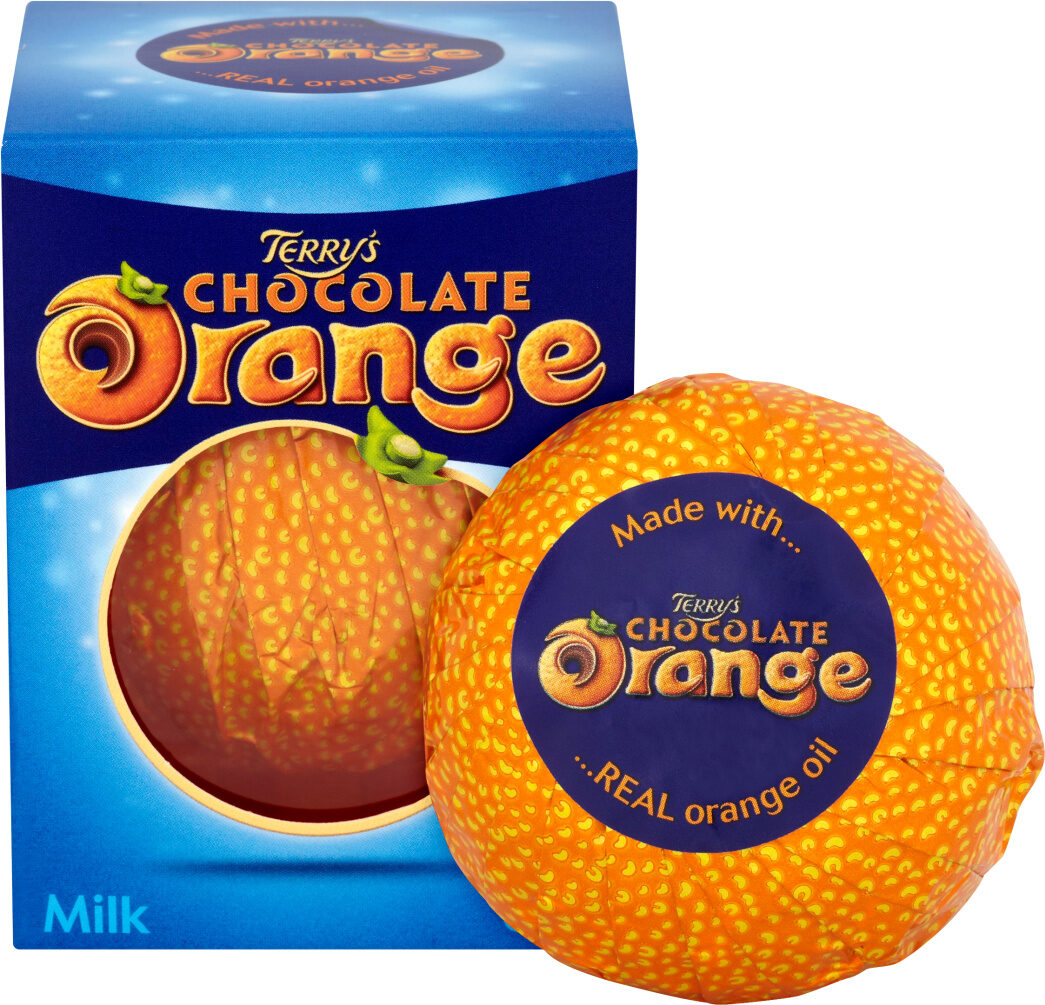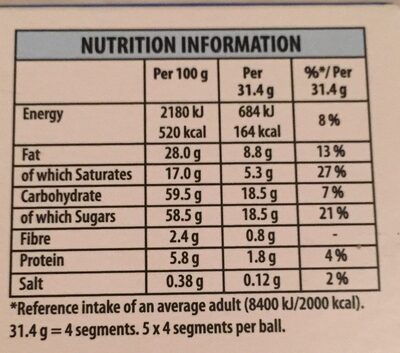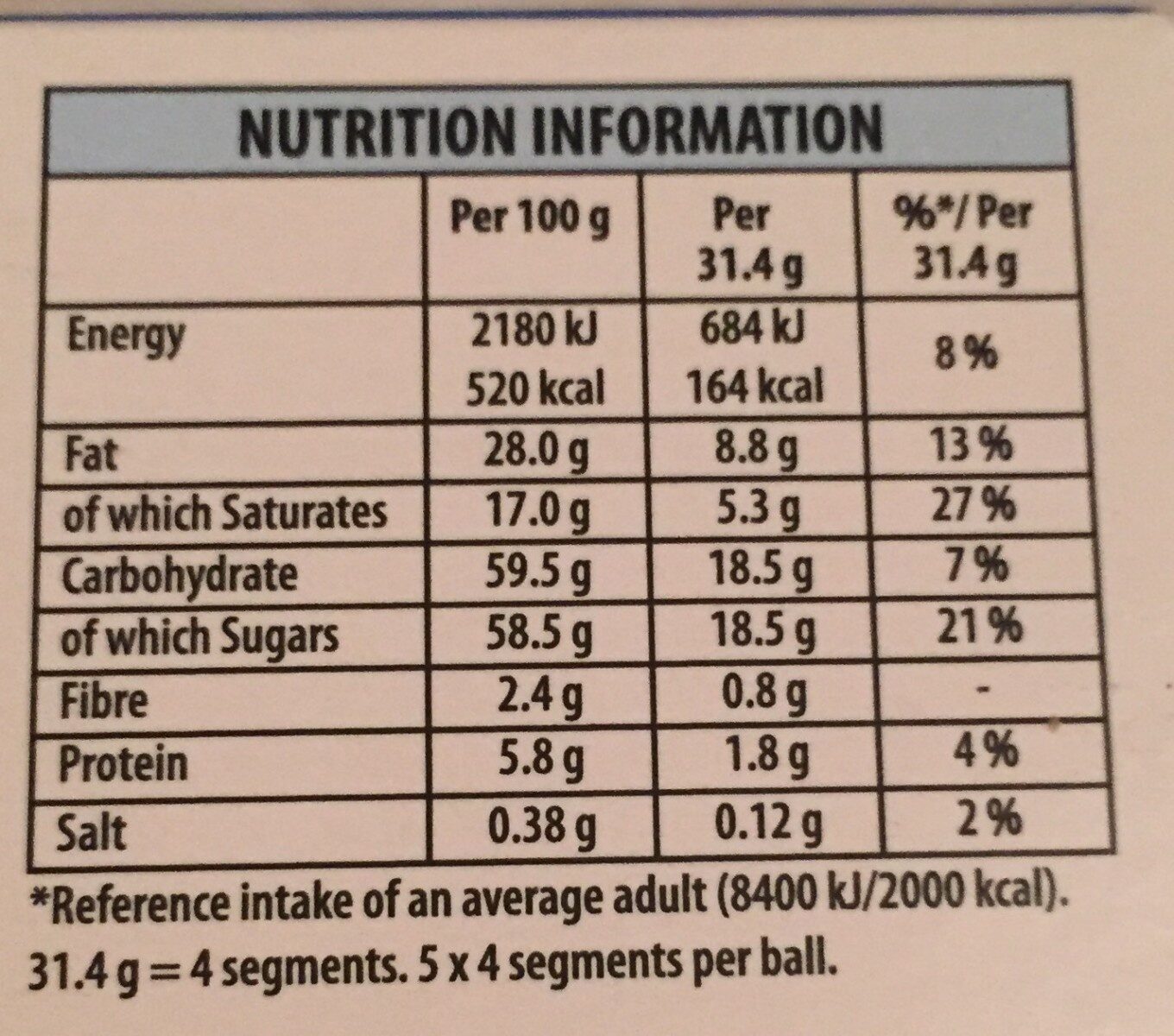Help us make food transparency the norm!
As a non-profit organization, we depend on your donations to continue informing consumers around the world about what they eat.
The food revolution starts with you!
Chocolate Orange Milk - Terry's - 157 g
Chocolate Orange Milk - Terry's - 157 g
This product page is not complete. You can help to complete it by editing it and adding more data from the photos we have, or by taking more photos using the app for Android or iPhone/iPad. Thank you!
×
Barcode: 3664346304863 (EAN / EAN-13)
Quantity: 157 g
Packaging: en:Sleeve, en:Card-box, en:Container, en:Foil-wrapper, en:Pet-tray, en:otherPlastic-sleeve, en:pet-sleeve
Brandaí: Terry's
Catagóirí: en:Snacks, en:Sweet snacks, en:Cocoa and its products, en:Confectioneries, en:Chocolates, en:Milk chocolates
Labels, certifications, awards:
en:Vegetarian, en:Green Dot
Country: An Ríocht Aontaithe, Stáit Aontaithe Mheiriceá
Matching with your preferences
Health
Comhábhair
-
15 ingredients
An Béarla: sugar, cocoa mass, cocoa butter, skimmed milk powder, whey powder (from milk), vegetable fats (palm, shea), milk fat, emulsifiers (soya lecithins, e476), orange oil, flavouringHailléirginí: Bainne, Pónairí soigheTraces: Glútan, Cnónna
Food processing
-
Ultra processed foods
Elements that indicate the product is in the en:4 - Ultra processed food and drink products group:
- Additive: E322
- Additive: E476 - Polairicineoláit pholaigliocróil
- Comhábhar: Eiblitheoir
- Comhábhar: Flavouring
- Comhábhar: Whey
Food products are classified into 4 groups according to their degree of processing:
- Unprocessed or minimally processed foods
- Processed culinary ingredients
- Processed foods
- Ultra processed foods
The determination of the group is based on the category of the product and on the ingredients it contains.
Additives
-
E322
Lecithin: Lecithin -UK: , US: , from the Greek lekithos, "egg yolk"- is a generic term to designate any group of yellow-brownish fatty substances occurring in animal and plant tissues, which are amphiphilic – they attract both water and fatty substances -and so are both hydrophilic and lipophilic-, and are used for smoothing food textures, dissolving powders -emulsifying-, homogenizing liquid mixtures, and repelling sticking materials.Lecithins are mixtures of glycerophospholipids including phosphatidylcholine, phosphatidylethanolamine, phosphatidylinositol, phosphatidylserine, and phosphatidic acid.Lecithin was first isolated in 1845 by the French chemist and pharmacist Theodore Gobley. In 1850, he named the phosphatidylcholine lécithine. Gobley originally isolated lecithin from egg yolk—λέκιθος lekithos is "egg yolk" in Ancient Greek—and established the complete chemical formula of phosphatidylcholine in 1874; in between, he had demonstrated the presence of lecithin in a variety of biological matters, including venous blood, in human lungs, bile, human brain tissue, fish eggs, fish roe, and chicken and sheep brain. Lecithin can easily be extracted chemically using solvents such as hexane, ethanol, acetone, petroleum ether, benzene, etc., or extraction can be done mechanically. It is usually available from sources such as soybeans, eggs, milk, marine sources, rapeseed, cottonseed, and sunflower. It has low solubility in water, but is an excellent emulsifier. In aqueous solution, its phospholipids can form either liposomes, bilayer sheets, micelles, or lamellar structures, depending on hydration and temperature. This results in a type of surfactant that usually is classified as amphipathic. Lecithin is sold as a food additive and dietary supplement. In cooking, it is sometimes used as an emulsifier and to prevent sticking, for example in nonstick cooking spray.Source: Wikipedia (An Béarla)
-
E476 - Polairicineoláit pholaigliocróil
Polyglycerol polyricinoleate: Polyglycerol polyricinoleate -PGPR-, E476, is an emulsifier made from glycerol and fatty acids -usually from castor bean, but also from soybean oil-. In chocolate, compound chocolate and similar coatings, PGPR is mainly used with another substance like lecithin to reduce viscosity. It is used at low levels -below 0.5%-, and works by decreasing the friction between the solid particles -e.g. cacao, sugar, milk- in molten chocolate, reducing the yield stress so that it flows more easily, approaching the behaviour of a Newtonian fluid. It can also be used as an emulsifier in spreads and in salad dressings, or to improve the texture of baked goods. It is made up of a short chain of glycerol molecules connected by ether bonds, with ricinoleic acid side chains connected by ester bonds. PGPR is a yellowish, viscous liquid, and is strongly lipophilic: it is soluble in fats and oils and insoluble in water and ethanol.Source: Wikipedia (An Béarla)
Ingredients analysis
-
en:Palm oil
Ingredients that contain palm oil: en:Palm
-
en:Non-vegan
Non-vegan ingredients: en:Skimmed milk powder, en:Whey powder, Bainne, en:Milkfat
-
en:Vegetarian
No non-vegetarian ingredients detected
Unrecognized ingredients: en:Orange essential oil
-
Details of the analysis of the ingredients
en: sugar, cocoa mass, cocoa butter, skimmed milk powder, whey powder (from milk), vegetable fats (palm, shea), milk fat, emulsifiers (soya lecithins, e476), orange oil, flavouring- sugar -> en:sugar - vegan: yes - vegetarian: yes - ciqual_proxy_food_code: 31016 - percent_min: 10 - percent_max: 100
- cocoa mass -> en:cocoa-paste - vegan: yes - vegetarian: yes - ciqual_proxy_food_code: 16030 - percent_min: 0 - percent_max: 50
- cocoa butter -> en:cocoa-butter - vegan: yes - vegetarian: yes - ciqual_food_code: 16030 - percent_min: 0 - percent_max: 33.3333333333333
- skimmed milk powder -> en:skimmed-milk-powder - vegan: no - vegetarian: yes - ciqual_food_code: 19054 - percent_min: 0 - percent_max: 25
- whey powder -> en:whey-powder - vegan: no - vegetarian: maybe - percent_min: 0 - percent_max: 20
- from milk -> en:milk - vegan: no - vegetarian: yes - ciqual_proxy_food_code: 19051 - percent_min: 0 - percent_max: 20
- vegetable fats -> en:vegetable-fat - vegan: yes - vegetarian: yes - from_palm_oil: maybe - percent_min: 0 - percent_max: 16.6666666666667
- palm -> en:palm - vegan: yes - vegetarian: yes - from_palm_oil: yes - ciqual_food_code: 16129 - percent_min: 0 - percent_max: 16.6666666666667
- shea -> en:shea-butter - vegan: yes - vegetarian: yes - from_palm_oil: no - percent_min: 0 - percent_max: 8.33333333333333
- milk fat -> en:milkfat - vegan: no - vegetarian: yes - from_palm_oil: maybe - percent_min: 0 - percent_max: 14.2857142857143
- emulsifiers -> en:emulsifier - percent_min: 0 - percent_max: 12.5
- soya lecithins -> en:soya-lecithin - vegan: yes - vegetarian: yes - ciqual_food_code: 42200 - percent_min: 0 - percent_max: 12.5
- e476 -> en:e476 - vegan: yes - vegetarian: yes - percent_min: 0 - percent_max: 6.25
- orange oil -> en:orange-essential-oil - from_palm_oil: no - percent_min: 0 - percent_max: 11.1111111111111
- flavouring -> en:flavouring - vegan: maybe - vegetarian: maybe - percent_min: 0 - percent_max: 5
Nutrition
-
Bad nutritional quality
⚠ ️Warning: the amount of fruits, vegetables and nuts is not specified on the label, it was estimated from the list of ingredients: 0This product is not considered a beverage for the calculation of the Nutri-Score.
Positive points: 2
- Próitéiní: 3 / 5 (value: 5.8, rounded value: 5.8)
- Fiber: 2 / 5 (value: 2.4, rounded value: 2.4)
- Fruits, vegetables, nuts, and colza/walnut/olive oils: 0 / 5 (value: 0, rounded value: 0)
Negative points: 27
- Energy: 6 / 10 (value: 2180, rounded value: 2180)
- Siúcraí: 10 / 10 (value: 58.5, rounded value: 58.5)
- Saturated fat: 10 / 10 (value: 17, rounded value: 17)
- Sodium: 1 / 10 (value: 152, rounded value: 152)
The points for proteins are not counted because the negative points are greater or equal to 11.
Nutritional score: (27 - 2)
Nutri-Score:
-
Nutrient levels
-
Saill as high quantity (28%)
What you need to know- A high consumption of fat, especially saturated fats, can raise cholesterol, which increases the risk of heart diseases.
Recommendation: Limit the consumption of fat and saturated fat- Choose products with lower fat and saturated fat content.
-
SáSitheáin saill as high quantity (17%)
What you need to know- A high consumption of fat, especially saturated fats, can raise cholesterol, which increases the risk of heart diseases.
Recommendation: Limit the consumption of fat and saturated fat- Choose products with lower fat and saturated fat content.
-
Siúcraí as high quantity (58.5%)
What you need to know- A high consumption of sugar can cause weight gain and tooth decay. It also augments the risk of type 2 diabetes and cardio-vascular diseases.
Recommendation: Limit the consumption of sugar and sugary drinks- Sugary drinks (such as sodas, fruit beverages, and fruit juices and nectars) should be limited as much as possible (no more than 1 glass a day).
- Choose products with lower sugar content and reduce the consumption of products with added sugars.
-
Salann as moderate quantity (0.38%)
What you need to know- A high consumption of salt (or sodium) can cause raised blood pressure, which can increase the risk of heart disease and stroke.
- Many people who have high blood pressure do not know it, as there are often no symptoms.
- Most people consume too much salt (on average 9 to 12 grams per day), around twice the recommended maximum level of intake.
Recommendation: Limit the consumption of salt and salted food- Reduce the quantity of salt used when cooking, and don't salt again at the table.
- Limit the consumption of salty snacks and choose products with lower salt content.
-
-
Nutrition facts
Nutrition facts As sold
for 100 g / 100 mlAs sold
per serving (Per 100 g (100 g))Compared to: en:Milk chocolates Fuinneamh 2,180 kj
(521 kcal)2,180 kj
(521 kcal)-4% Saill 28 g 28 g -15% SáSitheáin saill 17 g 17 g -11% Carbaihiodráit 59.5 g 59.5 g +12% Siúcraí 58.5 g 58.5 g +18% Snáithín 2.4 g 2.4 g +9% Próitéin 5.8 g 5.8 g -18% Salann 0.38 g 0.38 g +60% Fruits‚ vegetables‚ nuts and rapeseed‚ walnut and olive oils (estimate from ingredients list analysis) 0 % 0 %
Environment
-
Eco-Score E - Very high environmental impact
The Eco-Score is an experimental score that summarizes the environmental impacts of food products.→ The Eco-Score was initially developped for France and it is being extended to other European countries. The Eco-Score formula is subject to change as it is regularly improved to make it more precise and better suited to each country.Life cycle analysis
-
Average impact of products of the same category: D (Score: 38/100)
Catagóir: Milk chocolate bar
Catagóir: Milk chocolate bar
- PEF environmental score: 0.78 (the lower the score, the lower the impact)
- including impact on climate change: 12.74 kg CO2 eq/kg of product
Stage Impact Agriculture
43.5 %Processing
50.8 %Packaging
1.3 %Transportation
3.7 %Distribution
0.6 %Consumption
0.0 %
Bonuses and maluses
-
Missing origins of ingredients information
Malus: -5
⚠ ️ The origins of the ingredients of this product are not indicated.
If they are indicated on the packaging, you can modify the product sheet and add them.
If you are the manufacturer of this product, you can send us the information with our free platform for producers.
-
Ingredients that threatens species
Malus: -10
Contains palm oil
Tropical forests in Asia, Africa and Latin America are destroyed to create and expand oil palm tree plantations. The deforestation contributes to climate change, and it endangers species such as the orangutan, the pigmy elephant and the Sumatran rhino.
-
Packaging with a high impact
Malus: -15
Shape Material Recycling Impact Wrapper Unknown Ard container Unknown Ard Box Unknown Ard Tray PET Ard Sleeve Unknown Ard ⚠ ️ The information about the packaging of this product is not sufficiently precise (exact shapes and materials of all components of the packaging).⚠ ️ For a more precise calculation of the Eco-Score, you can modify the product page and add them.
If you are the manufacturer of this product, you can send us the information with our free platform for producers.
Eco-Score for this product
-
Impact for this product: E (Score: 8/100)
Táirge: Chocolate Orange Milk - Terry's - 157 g
Life cycle analysis score: 38
Sum of bonuses and maluses: -30
Final score: 8/100
-
Carbon footprint
-
Equal to driving 6.6 km in a petrol car
1274 g CO² per 100g of product
The carbon emission figure comes from ADEME's Agribalyse database, for the category: Milk chocolate bar (Source: ADEME Agribalyse Database)
Stage Impact Agriculture
31.2 %Processing
65.4 %Packaging
0.8 %Transportation
2.4 %Distribution
0.1 %Consumption
0.0 %
Packaging
-
Packaging with a high impact
-
Packaging parts
Wrapper
container
Box
Tray (PET)
Sleeve
-
Packaging materials
Material % Packaging weight Packaging weight per 100 g of product Plastic
-
Transportation
-
Origins of ingredients
Missing origins of ingredients information
⚠ ️ The origins of the ingredients of this product are not indicated.
If they are indicated on the packaging, you can modify the product sheet and add them.
If you are the manufacturer of this product, you can send us the information with our free platform for producers.Add the origins of ingredients for this product Add the origins of ingredients for this product
Threatened species
-
Contains palm oil
Drives deforestation and threatens species such as the orangutan
Tropical forests in Asia, Africa and Latin America are destroyed to create and expand oil palm tree plantations. The deforestation contributes to climate change, and it endangers species such as the orangutan, the pigmy elephant and the Sumatran rhino.
Report a problem
-
Incomplete or incorrect information?
Category, labels, ingredients, allergens, nutritional information, photos etc.
If the information does not match the information on the packaging, please complete or correct it. Open Food Facts is a collaborative database, and every contribution is useful for all.
Data sources
Product added on ag kiliweb
Last edit of product page on ag inf.
Product page also edited by bcatelin, charlesnepote, foodless, openfoodfacts-contributors, org-database-usda, packbot, quentinbrd, swipe-studio, vaporous, yuka.SEp3TUFxVWpuT2dVcC8wSDJVcjMzdDRwMjUveERVcVNHdW95SVE9PQ, yuka.sY2b0xO6T85zoF3NwEKvlmZWcPry_DDJPRzRlEOZ4PaPMbbXQ4tT8qyraKs.
Last check of product page on ag bcatelin.










